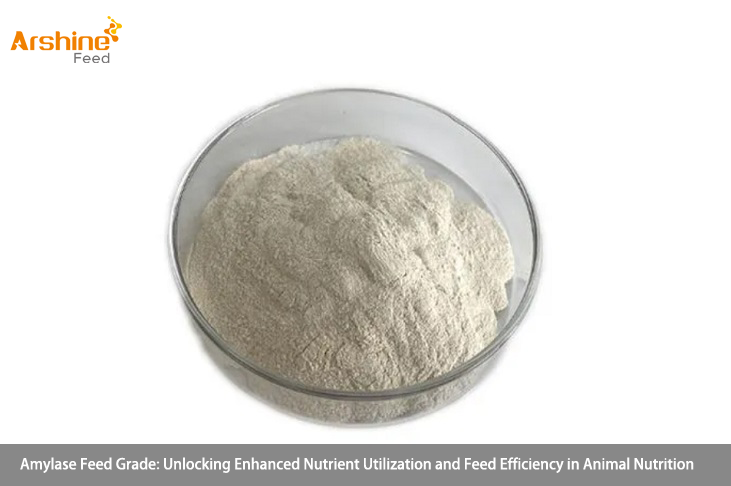

Introduction: Amylase feed grade, an essential enzyme derived from microbial sources, has emerged as a groundbreaking innovation in animal nutrition and feed formulation. With its ability to catalyze the hydrolysis of starch into simpler sugars, amylase plays a pivotal role in enhancing nutrient utilization, improving feed efficiency, and optimizing performance in various animal species. This comprehensive article delves into the applications, benefits, and regulatory considerations of amylase feed grade, shedding light on its transformative impact on modern animal agriculture.
Understanding Amylase Feed Grade: Amylase is a key digestive enzyme responsible for breaking down complex carbohydrates, such as starch and glycogen, into maltose, maltotriose, and dextrins, which are readily absorbable by the animal's digestive system. In its feed-grade form, amylase is produced through fermentation of selected microbial strains, followed by purification and quality control measures to ensure safety, efficacy, and compliance with regulatory standards for use in animal feed and feed additives.
Applications in Animal Nutrition: Amylase feed grade serves multiple functions in animal nutrition and livestock production, contributing to improved digestive health, enhanced nutrient absorption, and increased feed efficiency in various animal species. Some key applications include:
Starch Digestion and Nutrient Release: Amylase facilitates the breakdown of complex starch molecules present in feed ingredients such as grains, cereals, and tubers into simpler sugars, which can be easily digested and absorbed by the animal's digestive system. By enhancing starch digestion and nutrient release, amylase improves the availability of energy and essential nutrients, supporting optimal growth, development, and performance in poultry, swine, ruminants, and aquaculture species.
Feed Efficiency and Performance Enhancement: Supplementation of amylase feed grade in animal diets has been shown to improve feed conversion ratios, increase weight gain, and enhance overall performance parameters in livestock and poultry. By optimizing nutrient utilization, promoting digestive health, and reducing metabolic stress, amylase contributes to enhanced feed efficiency, improved digestibility, and increased profitability in animal production systems.
Gut Health and Microbiota Modulation: Amylase plays a crucial role in supporting gut health, microbial balance, and immune function by promoting the growth of beneficial gut bacteria and inhibiting the proliferation of pathogenic microorganisms. It helps maintain intestinal integrity, modulate immune responses, and enhance microbial diversity, thereby reducing the risk of digestive disorders, intestinal inflammation, and disease susceptibility in animals.
Environmental Sustainability and Waste Reduction: Amylase feed grade contributes to environmental sustainability and waste reduction in intensive livestock production systems by improving nutrient utilization efficiency and reducing feed wastage. By optimizing the digestion and absorption of dietary starch, amylase helps minimize nutrient excretion, reduce environmental pollution, and enhance nutrient recycling within the animal production ecosystem.
Regulatory Considerations and Safety: While amylase feed grade is generally recognized as safe (GRAS) when used in accordance with Good Manufacturing Practices (GMP) and applicable regulations, its use in animal feed and feed additives is subject to regulatory oversight by health authorities, including the U.S. Food and Drug Administration (FDA), European Food Safety Authority (EFSA), and other relevant agencies worldwide. These agencies establish maximum allowable levels, quality specifications, and permissible applications of amylase in animal feed to ensure safety, efficacy, and compliance with industry standards.
It is essential for feed manufacturers, producers, and veterinarians to adhere to regulatory guidelines and specifications regarding the use of amylase feed grade, including labeling requirements, maximum permitted levels, and quality control measures. Comprehensive safety assessments, efficacy studies, and quality assurance protocols should be implemented to ensure the purity, consistency, and safety of amylase-based feed products.
Conclusion: Amylase feed grade represents a revolutionary advancement in animal nutrition and feed management, offering a natural, effective, and sustainable solution for promoting digestive health, enhancing nutrient utilization, and optimizing feed efficiency in livestock and poultry production. Its diverse applications, proven benefits, and regulatory compliance make it an indispensable component in modern animal feed formulations and feed additive solutions.
By understanding the uses, advantages, and regulatory considerations associated with amylase feed grade, feed industry stakeholders can leverage its potential to optimize animal health, maximize production efficiency, and meet the evolving demands of consumers for safe, nutritious, and responsibly produced animal products. As the global focus on sustainable agriculture, animal welfare, and food safety continues to grow, the strategic incorporation of amylase feed grade into animal nutrition strategies offers promising opportunities for innovation, growth, and excellence in the dynamic landscape of animal agriculture.
Add: Block 14, No.100, Luyun Road,Changsha 410205,China.
Mobile: +86 18874001228
Email: info@arshinefeed.com
WhatsApp: 8618874001228
WeChat: weiyuyan91